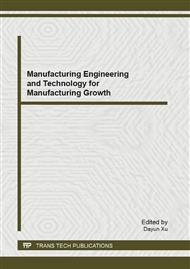p.445
p.451
p.461
p.469
p.476
p.482
p.486
p.491
p.497
Different Methods of Cutting Fluid Application on Turning of a Difficult-to-Machine Steel
Abstract:
Different methods of cutting fluid application are used on turning of a difficult-to-machine steel (SAE EV-8). A semi-synthetic cutting fluid was applied using a conventional method, minimum quantity of cutting fluid (MQCF), and pulverization. By the minimum quantity method was also applied a lubricant of vegetable oil (MQL). Thereafter, a cutting fluid jet under high pressure (3.0 MPa) was singly applied in the following regions: chip-tool interface; top surface of the chip; and tool-workpiece contact. Two other methods were used: an interflow between conventional application and chip-tool interface jet and, finally, three jets simultaneously applied. In order to carry out these tests, it was necessary to set up a high pressure system using a piston pump for generating a cutting fluid jet, a Venturi for fluid application (MQCF and MQL), and a nozzle for cutting fluid pulverization. The output variables analyzed included tool life, surface roughness, cutting tool temperature, cutting force, chip form, chip compression rate and machined specimen microstructure. It can be observed that the tool life increases and the cutting force decreases with the application of cutting fluid jet, mainly when it is directed to the chip-tool interface. Excluding the methods involving jet fluid, the conventional method seems to be more efficient than other methods of low pressure.
Info:
Periodical:
Pages:
476-481
Citation:
Online since:
December 2012
Authors:
Price:
Сopyright:
© 2013 Trans Tech Publications Ltd. All Rights Reserved
Share:
Citation:


